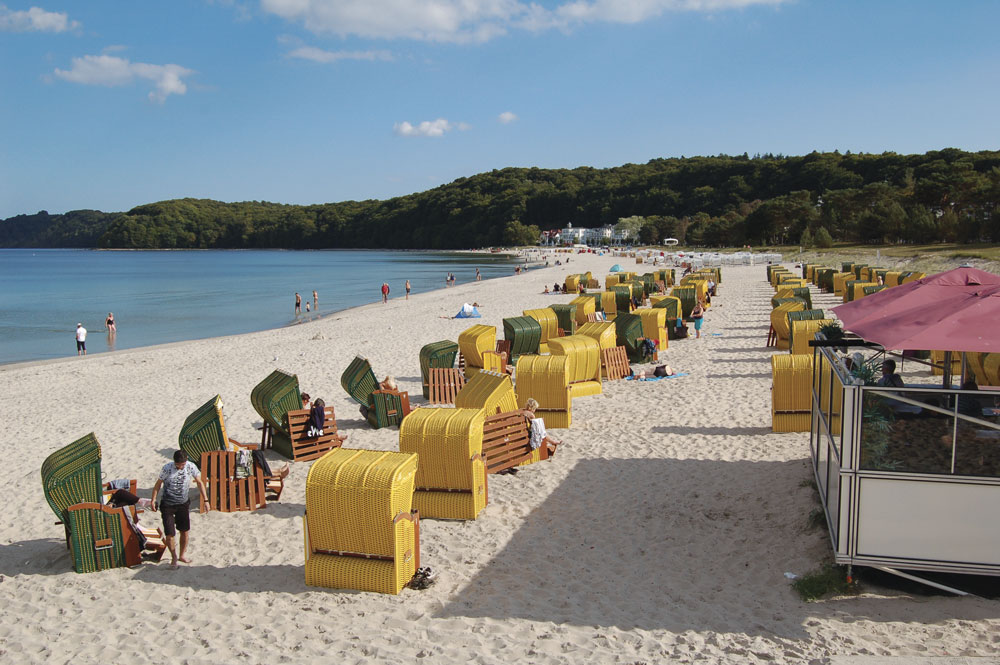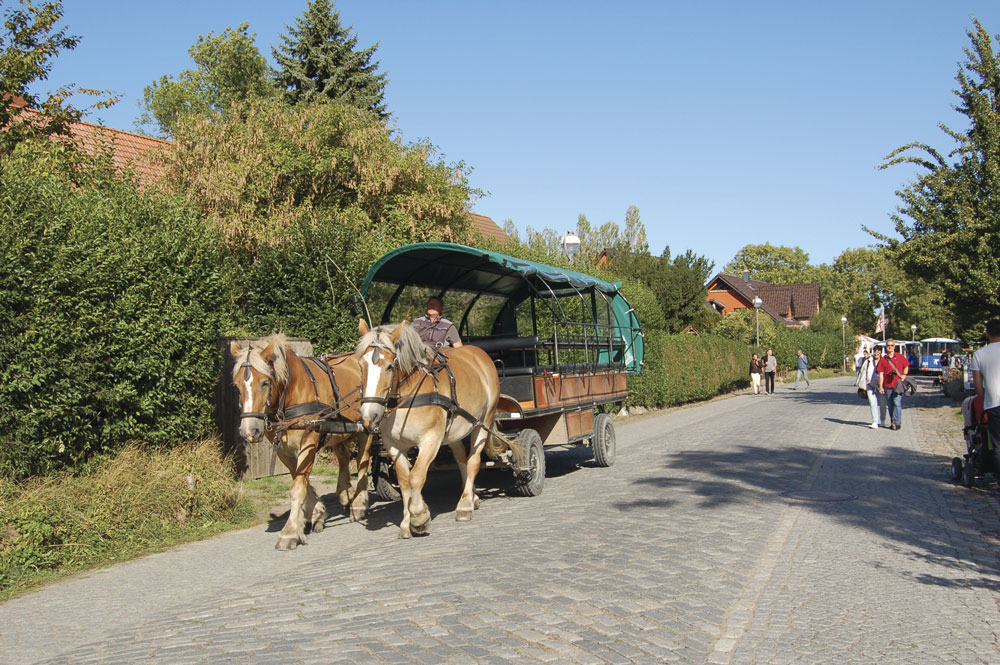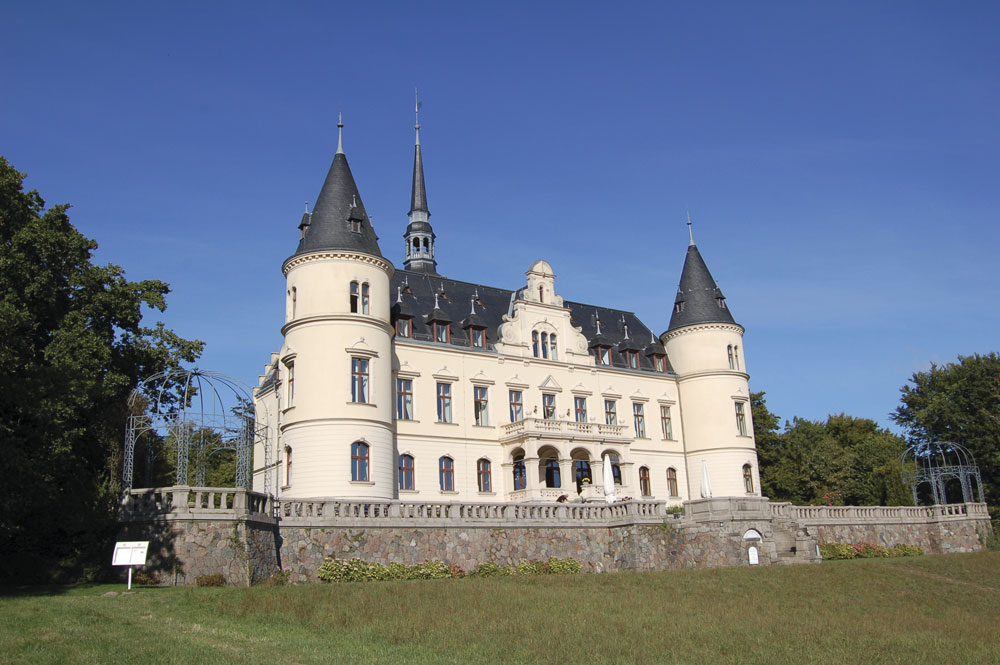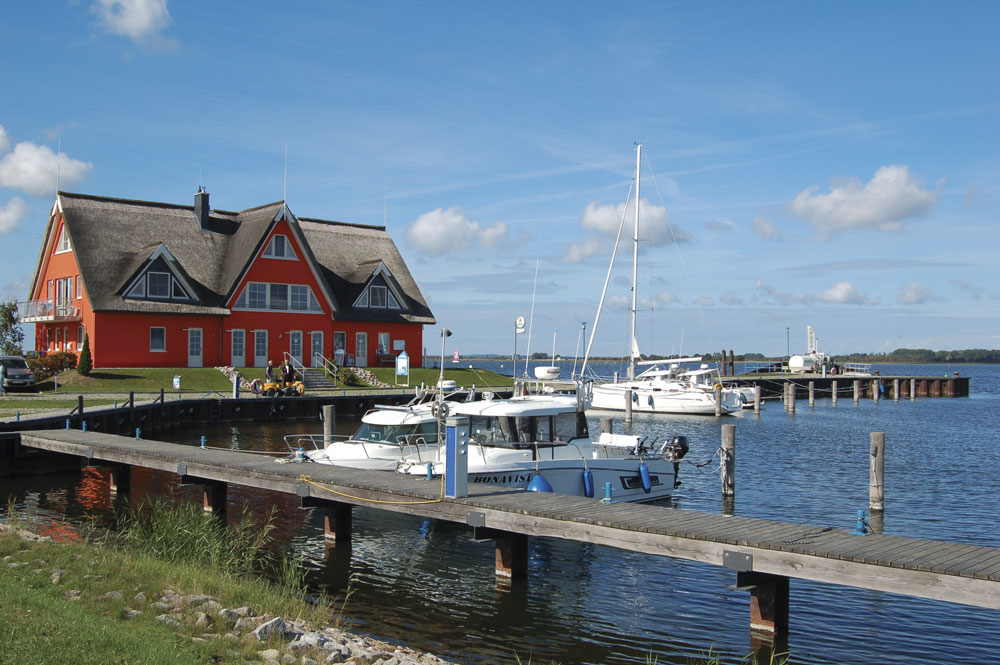Motorhome travel: Rügen, a German island in the sun
Words and photos by Judy Smith
Have you ever heard of Rügen? You haven’t? Well, nor had we until, whilst waiting for a not-too-pleasant spell in the dentist’s chair, I picked up a diversionary magazine from the coffee table. There it was, this German island in the Baltic – all white sand, white cliffs, white villas and swans swimming in a cobalt sea. We decided we needed to go there.
That was a couple of years ago and now, when we finally cross the bridge to Rügen, the first thing we see is a massive building site – a motorway is being built along the first 10 miles or so of our road. Not quite the idyllic island we’d expected.
Next day, cycling the couple of miles from our first-class campsite into the resort of Binz, we change our minds. There’s a quote attributed to Bismarck: “At the end of the world, go to Rügen. Everything happens a hundred years later there.” In Binz, you can see what he was getting at.

We push our bikes down a very long promenade edged with ornate white-painted villas from the Belle Époque period. On the other side, the silvery sand is dotted with strandkörbe, those typically Baltic basket/deckchairs, and folk are wandering along an old-fashioned wooden pier that stretches way out to sea.
With not a funfair or candy floss stall in sight, there’s an air of refinement in Binz. Blazers and flannels are not out of place, nor are flowery dresses and smart shoes. The natural accoutrement to all this seems to be a dachshund. These little dogs are everywhere, mostly right under our feet.
Binz has another promenade, one along an inland sea. We soon realise quite a lot of Rügen is inland sea, with lagoons known as bodden. Here in Binz they’ve endowed the inland promenade with some fine bronze statues and modern fountains.
Walking along we make our first acquaintance with fish rolls (fischbrötchen).
I suppose everyone knows that the Teutonic constitution needs frequent refuelling with bratwurst. Here on Rügen, fish rolls seem to have taken over and my husband, Eric, soon becomes addicted. The contents have strange names: brathering, matjes, bismarck – all of which seem to be preparations of herring. I should let Eric carry on at this point and you would have a whole article about fish rolls.
Binz is the largest resort on Rügen, but a few other resorts down the coast are served by a narrow-gauge railway, with a steam engine named Rasender Roland (Rushing Roland). This is an inappropriate moniker as its top speed is about 20mph. We manage to miss Roland (he doesn’t go that frequently) and, instead, take the motorhome to the next resort, Sellin.
When we find a tiny car park it’s raining and there’s not a soul around. Clearly downhill is the way to any beach – except that, in this case, we arrive at another inland sea and an amused couple tell us that the beach we’re looking for is back up the hill again. Of course, the climb ends in a cliff, with a lift down to the beach and some fairly precipitous steps alongside, but it’s a view that stuns.
There below us is this fabulous pier designed in the 1920s, with the strandkörbe arranged in geometric lines on the pristine sand alongside. As we stand admiring the classic scene, the sun makes its only brief appearance that day, turning the sea from grey to deep blue. Heaven knows why we’re so lucky; when you see something really worth a photograph, it usually starts to rain.
Göhren is said to have the best beach of all among the resorts in this southeast corner of the island but, somehow, we find it less appealing. Maybe nothing looks as good in a downpour.
Driving on, we soon recognise another foible of this island; without warning the surfaced carriageway can suddenly become crockery-rattling cobble, even on a main road. You also need to be an alert driver, because every road in both town and country is very closely lined with trees. There are lots of trees on Rügen.
One day we cycle through the forest to a hunting lodge – Jagdschloss Granitz – built by a prince of Rügen some 300 years ago. It’s a pretty rose-pink affair, but its outside appearance belies its contents. The boars’ heads and antlers in the foyer are enough for us and we go no farther.
The forest behind our campsite holds something quite different. It’s a short walk to the Baumwipfelpfad (otherwise known as the Eagle’s Nest), a wooden spiral walkway rising high above the trees for a magnificent view. There are no steps here; the gradient is suitable for pushchair or wheelchair, which makes the whole coiled length almost a mile. In case you get dizzy, there are diversions on the way.
From this height we see flocks of swans on the inland sea below and catch our first sight of something with more sinister connotations, Prora. In the woods behind the beach and quite close to our campsite, stretches a building some three miles long and six storeys high.
This is Prora, a holiday complex of 11,000 identical rooms instituted by Hitler as part of his ‘Strength through Joy’ programme. The idea was to provide two weeks’ holiday each year for the country’s lowest-paid workers. There were cinemas and dance halls and every room had a sea view.
The complex was never finished, war intervened and no one ever took a holiday there. Prora was left to crumble but, in the last few years, developers have moved in. The severe grey concrete building is being converted into shiny white apartments with glass balconies and swimming pools. If you want one of these, you’ll need half-a-million euro and, apparently, they are selling like hot cakes. It seems that the past is forgotten.
We set out to find the original Prora, the unconverted north end of the building. All we can find is a fenced-off shell rising gauntly above the pine trees.
Prora fronts a beautiful long beach, one that at least in part bears the textil sign. The old GDR regime considered nakedness to be healthy, hence all beaches on Rügen and elsewhere were nudist. If you don’t want a bit of a surprise today, you need to look out for that word ‘textil’.
Everyone around us seems to be conforming to Textil, so we walk home along the sand with our eyes peeled, resuming our search for amber. I think we aren’t looking in the right places as amber washes up all along these shores and others seem to have a lot more success than we do.
Rügen’s most renowned forest is in the north of the island. Here, the venerable stands of beeches with their fringe of pure white chalk cliff have earned the Jasmund National Park World Heritage status. Sadly, we find it just too commercialised for us.
We pay to park the motorhome, we pay for the shuttle bus and we pay for entry into the park itself. The exhibition and its video are good and the chalk cliffs, which everyone comes to see, are spectacular and a lot more sparkling than those at Dover.
But, with so many visitors, it’s difficult to get a view of the best ones: the Königsstuhl (King’s Chair) and Viktoriasicht (named after our own queen). I think we’d have done better to take the six-mile walk in through the forest from Sassnitz, further down the coast.
The Jasmund Park is the one disappointment; we can only blame ourselves for the later confusion at Cape Arkona. With quite a lot of visitors, the lighthouses of Germany’s northernmost point can only be accessed by shuttle train from the car park.

We somehow manage to misread all the German signs and find ourselves driving alone through a village of artists and then on a one-track road facing the oncoming train. We leave quite promptly after that, only pausing for a quick glass of sanddorn juice to keep us going.
Everyone on Rügen seems to drink sanddorn juice. Sanddorn (sea buckthorn to us) grows only in the Himalayas and the Baltic and it’s packed with vitamins and every other good thing. The amber-coloured juice is quite ambrosial and you can go for other products, like sanddorn jelly babies (which are delicious) and sanddorn wine, (which isn’t very nice at all).
Coming to the end of our holiday we realise we haven’t seen the more off-the-beaten-track west of the island. Our trip there begins with one of those big red crosses used to close German roads and there are no signs to tell us where to go.
Our trusty map takes us on a road that soon degenerates into two separated lines of concrete slabs and we wonder what to do if anything comes the other way.
Fortunately, it doesn’t and this Heath Robinson road takes us to where we’d never intended to go, a village on the shores of a bodden.
Ralswiek is beautiful. A big red boat in the harbour is selling its own smoked fish rolls, which sets the tone for the day. After that, we wander through a little pleasure port and up to a handsome castle with never another soul around.

There must be folk at some time, though, because there’s a theatre here and a poster telling us it has firework displays on summer evenings. Ralswiek is surely the most attractive spot on the island. That diversion turned out to be a good thing.
We want to see more and head north to another harbour at Vieregge. Again, it’s pretty and the lovely orange-hued harbourmaster’s house is strongly reminiscent of Danish architecture.

Coming back, we pass a site where they’re building an observation tower. It’s not finished, but the workmen let me up for the fabulous view. I think they’re surprised to have English visitors. We haven’t seen a single British vehicle the whole time. We find ourselves on another of those concrete slab roads on the way home. This side of the island is like another world.
On our last afternoon we return to the seafront at Binz. We haven’t been down this far end before; the villas are some of the best and Eric’s spotted, from the pier, a curious building that he thinks he’s seen on TV.
It turns out to be a sort of rectangular goldfish bowl with rows of seats inside, the winner of a design award.
Goodness knows what it is used for, but it must be hot in there.
We end up in a family-owned beach restaurant, where they have been smoking fish for five generations. Yes, more fish rolls…
As we sit, we reflect on how different Rügen is: swans, sanddorn, villas, amber, cobbled roads, thatched houses, strandkörbe and textil beaches. We’re so glad that we didn’t wait for the end of the world to come here.
If you enjoyed this article, you can read more travel tales from motorhomers and campervanners in every issue of MMM. Click here to buy digital issues of the magazine.








Recent Updates
Engine management lights: all you need to know
What is the engine management light? What does it mean, and what do I have to do? ...
Motorhome air suspension: all you need to know
Motorhomes are heavy and the additional weight of equipment and height of the bodywork can increase the loads ...
Motorhome WiFi: how to get better motorhome internet
Staying connected on the move is more and more essential, so relying on campsite WiFi isn't an option – here ...
A class of their own - our guide to A-class motorhomes
Thinking of trading up to an A-class, or even going straight to the top of the motorhome tree? We guide you ...
Explore overseas on a motorhome dream tour
Enjoy exotic travel in a campervan or motorhome by hiring, swapping with someone else or exporting your ...
Motorhome water systems: everything you need to know
On-board water is an important part of every motorhome – here’s everything you need to know ...
Campervanning in Europe: what you need to know
Whether you're planning a leisurely drive through the French countryside, navigating bustling city streets in ...
Campervan security: all you need to know
With thefts on the increase, it’s important to know how to keep your campervan secure and prevent campervan ...
Campervan furniture: everything you need to know
Our campervan experts guide you through all the essentials for your campervan, including tables, chairs, ...
Campervan finance: how to fund your purchase
Here we look at the different types of campervan finance available, to help you decide what’s the best option ...
Other Articles
Britain’s best used motorhomes
Want a great motorhome without paying the premium for a new one? Here's a guide to the best you can get in the pre-owned market for each layout, ...
Which motorhome? Choosing the perfect motorhome for you
Choosing a motorhome or campervan is one of the biggest buying decisions you’ll ever make, so it's important ...
Campervan washroom essentials: stay fresh on the road
Our guide will take you through the campervan washroom essentials you'll need so you're well-prepared for ...
Dogs in campervans: all you need to know
Follow our advice and your dog will enjoy campervanning as much as you do ...
Electric campervans: all you need to know
Our guide will take you through everything you need to know about electric campervans and what the future ...
Motorhome electrics: a complete guide to your motorhome electrical set-up
Motorhome electrics can dramatically enhance the convenience and comfort of your vehicle – but they can be ...
Lighting for campervans: all you need to know
We guide you through all the lighting options available for you and your campervan, including interior ...
Electric bikes for motorhomes: our ultimate guide
Read our comprehensive guide to electric bikes for motorhome owners, helping you add electric power to your ...
Our guide to 'cheap' motorhomes in 2024
If you're on the hunt for an affordable new motorhome, this is the best place to start – we've rounded up a ...
Campervans in winter: all you need to know
Here's your guide to preparing your campervan for the colder months, whether you will be using it or putting ...